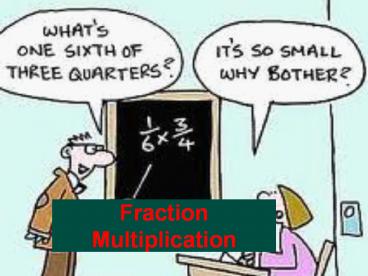Fraction Multiplication PowerPoint PPT Presentation
1 / 22
Title: Fraction Multiplication
1
Fraction Multiplication
2
There are 3 approaches for modeling fraction
multiplication
- A Fraction of a Fraction
- Length X Width Area
- Cross Shading
We will now examine each of these 3 approaches.
3
Area of a Rectangle
What is the area of this rectangle?
To find the area of a rectangle we can multiply
the length by the width.
Area Length X Width 4 x 3 12 units2
4
To find the answer to , we will use the
model to find of .
We use a fraction square to represent the
fraction .
5
Then, we shade of . We can see that it is
the same as .
6
In this example, of has been shaded
What is the answer to ?
X
7
- Modeling multiplication of fractions using the
fraction of a fraction approach requires that the
children understand the relationship of
multiplication to the word of. - We can establish this understanding showing
whole-number examples like 6 threes is the same
as 6 X 3.
8
We will think of multiplying fractions as finding
a fraction of another fraction.
We use a fraction square to represent the
fraction .
9
Then, we shade of . We can see that it is
the same as .
But, of is the same as .
X
So,
10
In the second method, we will think of
multiplying fractions as multiplying a length
times a width to get an area.
11
In the second method, we will think of
multiplying fractions as multiplying a length
times a width to get an area.
12
We think of the rectangle having those sides.
Its area is the product of those sides.
13
We can find another name for that area by seeing
what part of the square is shaded.
14
We have two names for the same area. They must
be equal.
15
Length X Width Area
This area is X
16
What is the answer to X ?
17
- Modeling multiplication of fractions using the
length times width equals area approach requires
that the children understand how to find the area
of a rectangle. - A great advantage to this approach is that the
area model is consistently used for
multiplication of whole numbers and decimals.
Its use for fractions, then is merely an
extension of previous experience.
18
In the third method, we will represent both
fractions on the same square.
is
19
The product of the two fractions is the part of
the square that is shaded both directions.
X
is
is
20
We will look at another example using cross
shading. We shade one direction.
21
Then we shade the other direction.
The answer to X is the part that is
shaded both directions.
22
The End

